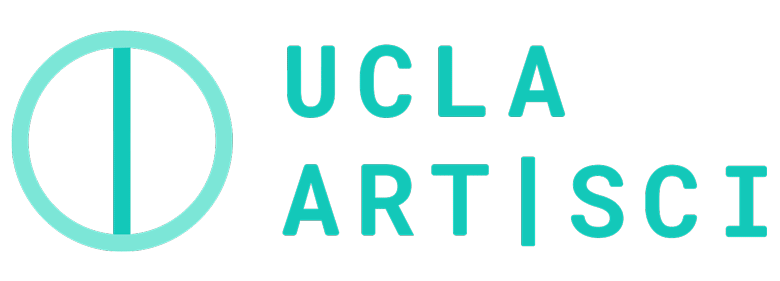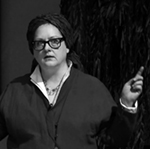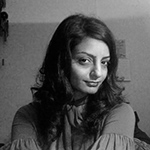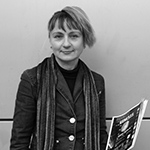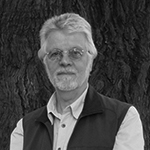Residents
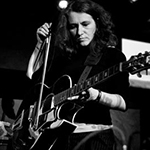
Anna Nacher
Anna Nacher, PhD, associate professor at the Jagiellonian University. Her research interests include digital culture, cultural theory, media art, sound studies and e-literature. She currently pursues a 3-year long research project on the aesthetics of post-digital imagery on a grant from Polish National Science Centre. The author of three books in Polish, the newest one published in 2016 focuses on the locative media imagery. A reworked version of one chapter has been published as "Internet of things and automation of imaging: beyond representationalism" in "communication+1", vol. 5 (2016). Other articles and chapters in edited volumes include: Techno-ecological media installations as the strategy of network, in: R. Smite, R. Smits eds. Virtualities and Realities. New Experiences, Art, and Ecologies in Immersive Environments, RIXC Center for New Media Culture, Riga 2019; In Praise of the (Post) Digital, Electronic Book Review, 5. Aug. 2018; Masaki Fujihata – On the Existence of Technical Objects, [w:] red. R. W. Kluszczyński, Augmenting the World. Masaki Fujihata and Hybrid Space-Time Art, Centrum Sztuki Współczesnej ŁAŹNIA, Gdańsk 2017; Mashup as paratextual practice: beyond digital objects (in the age of networked media), a chapter in N. Desrochers, D. Apollon (eds.), Examining Paratextual Theory and its Application in Digital Culture, Information Science Reference, IGI Global 2014. In 2018 a member of the jury for Electronic Literature Organization's N. Katherine Hayles Award for Criticism of Electronic Literature. She is also a part-time musician and sound artist focusing on field recordings.

Anne Niemetz
An Art|Sci Center alumni—will be joining us at the end of the quarter as the Bermant Foundation Resident. Anne is a media artist and designer working in the fields of wearable technology, interactive installation and audio-visual design. She is particularly fascinated by the convergence of art, science, design and technology, and she pursues collaborative and cross disciplinary projects.

Bill Fontana
I began my career as a composer. What really began to interest me was not so much the music that I could write but the states of mind I would experience when I felt musical enough to compose. In those moments, when I became musical, all the sounds around me also became musical. I have worked for the past 50 years creating installations that use sound as a sculptural medium to interact with and transform our perceptions of visual and architectural settings. These have been installed in public spaces and museums around the world including San Francisco, New York, Rome, Paris, London, Chicago, Vienna, Berlin, Venice, Sydney, Tokyo, Barcelona, Linz, Manchester, Istanbul and Abu Dhabi. My sound sculptures use the human and/or natural environment as a living source of musical information. I am assuming that at any given moment there will be something meaningful to hear and that music, in the sense of coherent sound patterns, is a process that is going on constantly. My methodology has been to create networks of simultaneous listening points that relay real time acoustic data to a common listening zone (sculpture site). Since 1976 I have called these works sound sculptures. I have produced a large number of works that explore the idea of creating live listening networks. These all use a hybrid mix of transmission technologies that connect multiple sound retrieval points to a central reception point. What is significant in this process are the conceptual links determining the relationships between the selected listening points and the site-specific qualities of the reception point (sculpture site). Some conceptual strategies have been acoustic memory, the total transformation of the visible (retinal) by the invisible (sound), hearing as far as one can see, the relationship of the speed of sound to the speed of light, and the deconstruction of our perception of time.

Clarissa Ribeiro (Brazil)
http://www.clarissaribeiro.com/
Clarissa Ribeiro, Ph.D. in Arts, M.Arch, B.Arch, former Fulbright Scholar in Arts and Science, LASER talks’ chair in Brazil. With an interest in generative strategies in nature and in the algorithmic realm of computers, Clarissa Ribeiro explores form, effectiveness and consciousness as emergent phenomena in the most diverse systems and scales in both media arts and architecture. In her artistic practice and teaching, she navigates the universes of morphogenetic design in dialogue with robotics and digital fabrication, visual/media arts in dialogue with bioart/art and science strategies, exhibiting and working in collaboration with other artists, scientists, research groups and art collectives in her home country and abroad.
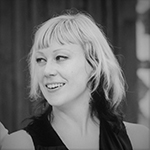
Claudia Schnugg
Claudia Schnugg is a researcher, educator, producer, and curator with an interdisciplinary background in social sciences, business administration, cultural sciences, and the arts. Currently, she is exploring the practices and social dynamics of interdisciplinary collaborative projects, involving art, science, and new technologies. Apart of her research projects she is working with institutions like Science Gallery International to support them in developing research proposals and artscience research opportunities, and consults scientific institutions in the development of artscience projects, artist in residence programs, and artscience interventions. Previously, she curated the Ars Electronica Residency Network. This included EU projects and programs in cooperation with institutions like CERN, ESO (European Southern Observatories), Queensland University of Technology, voestalpine, and Chungnam Culture Technology Industry Agency. Prior academic positions include an Assistant Professorship at the Johannes Kepler University, Linz, and a Visiting Postdoctoral Research Position at Copenhagen Business School, with special focus on organizational aesthetics and artistic interventions in business contexts.
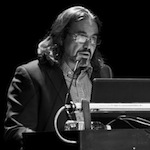
Edward Shanken (United States)
dward A. Shanken writes and teaches about the entwinement of art, science, and technology with a focus on interdisciplinary practices involving new media. He is Director of the Digital Arts and New Media (DANM) MFA program at UC Santa Cruz and Associate Professor in the Arts Division. Prior academic posts include Digital + Media MFA program at Rhode Island School of Design, DXARTS Ph.D. program at University of Washington, New Media International MA at University of Amsterdam. Fellowships include National Endowment for the Arts, American Council of Learned Societies, UCLA, University of Bremen, University of Memphis, and Washington University in St. Louis. Dr. Shanken earned a Ph.D. and MA in Art History at Duke University, an MBA at Yale University, and a BA at Haverford College.
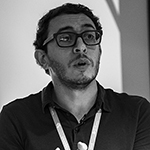
Haytham Nawar (Egypt)
http://www.aucegypt.edu/fac/haythamnawar
Nawar is an artist, designer, and researcher who currently lives and works in Cairo. He is Assistant Professor and Director of the Graphic Design program, Department of the Arts at the American University in Cairo. He is the founder and director of the Cairotronica, Cairo Electronic, and New Media Arts Festival. Nawar received his Ph.D. from the Planetary Collegium, Center for Advanced Inquiry in Integrative Arts, School of Art and Media - University of Plymouth. He holds a Masters of Advanced Studies ZFH in Spatial Design, Institute of Design & Technology, Zurich University of the Arts, Switzerland and an MFA in New Media and BFA in Printmaking from the Faculty of Fine Arts, Cairo, Egypt. He is a Fulbright alumni. Since 1999, he has participated in several international exhibitions, biennales, and triennials, the latest of which was Venice Biennial in 2015. Nawar won awards and acquisitions nationally and internationally in Algeria, Bosnia and Herzegovina, China, Cyprus, Egypt, France, Greece, Germany, Italy, Japan, Lithuania, Portugal, Kuwait, Spain, South Africa, South Korea, Switzerland, Syria, UAE and the United States.

Iman Person
IMAN PERSON is a first-generation Jamaican-American artist and cultural anthropologist whose research explores the intersections of Black and Indigenous technologies, and their connections to ritual, the land, language, and cosmic time. Her work goes beyond traditional Western views of technology to offer a somatic examination of cultural diasporas within the Americas and the Caribbean. In her practice, she sees the body as deeply connected to the elements, with her recent works focusing on air and ether as points of convergence for exploring collective histories, migration, and diasporic memory. Using Africana cosmologies and personal experience, Iman channels speculative visions of Black futurity through intuitive writing, video, real-time data, experimental sound, sensory ethnography, and object-making to shape unexplored ideas concerning living archives and sovereignty while navigating the delicate terrain occurring at the edges of multiple worlds. Click Here To Learn More: https://us8.admin.mailchimp.com/campaigns/wizard/neapolitan?id=2552689 An emerging area of focus for me is does sound have the capacity to embody space fully in place of the moving image. Can audiences journey and comprehend a location solely through sonic spaces and if so, where does this sound take them? Can a new destination be formed that exists outside of the present or the past by altering timescapes through sound? The core of this research engages with Kamau Bratherwaite's concept of alter/native language, which defines types of narratives that have the power to transform psychology and ways of knowing within communities of the African diaspora, which Bratherwaite believes are inherited from the teachings of colonization and the ideologies of the “mother country.” Forming alter/native languages is a discursive method that can initiate the process of re-orientation and nativizing something that has no native land to construct a more authentic voice of marginalized peoples. Brathwaite believes these languages are essential to understanding the Caribbean experience, as they reflect the region's diverse and complex cultural heritage, and provide a window into the lived experiences of its people. Not only is this creolization a melding of English or French dialects with the African or the Amerindian, but this language is also infused with the landscape itself. The weather, the quality of air, erosion, its flora, and humidity...these all alter the words created and expressed throughout the Caribbean and diasporic communities. The archives that I am currently incorporating into the work are audio are collections from prominent Caribbean linguists, narrations and reflections of the mass West Indian migration into England during 1945- 1960, lyrical prose (both self-written and found), ethnobotany and its relationship to colonial narratives in Jamaica, as well as musical excerpts of Jamaica’s sonic journey from Kuminia to present day. This project delves into sound at the juncture of Blackness and technology through codified languages that have emerged through Jamaican Patois, West Indian Creole, and other tribal communities.
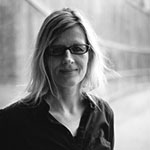
Ina Conradi
Ina Conradi, Associate Professor at the Nanyang Technological University Singapore, School of Art, Design and Media, is an award-winning digital new media artist living and working in Singapore. Her works innovatively span several disciplines: digital painting, experimental stereoscopic animation, installation, architecture and new media. Ina’s research interests are in new media art investigations through art form that redefines the wide spectrum of what painting can be. Her explorations define the new pictorial experiences that translate traditional physical act of painting into variable media spaces, innovatively employing digital animation, VFX, and since 2010 stereography.
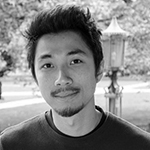
Joel Ong
https://arkfrequencies.com/joel
Joel Ong (PhD, MSc.Bioart) is a media artist whose works connect scientific and artistic approaches to the environment. His recent works explore the visibility and audibility of ambient phenomena with a particular focus on the wind and the atmospheric microbiome. His individual and collaborative works have been shown at festivals and galleries internationally such as the Currents New Media Festival, Nuit Blanche Toronto, ISEA, the Seattle Art Museum, the Gregg Museum of Art and Design, the Penny Stamps Gallery and the Ontario Science Centre. Joel is an alumni of SymbioticA, the Centre of Excellence in Biological Arts in Perth, Western Australia, and holds a PhD from DXARTS at the University of Washington. He was a recipient of the Petro-Canada Young Innovators Award in 2020 and is currently an artist with the Biofrictions Creative Europe transdisciplinary research project. He is Assistant Professor in Computational Arts and Director of Sensorium:The Centre for Digital Arts and Technology at York University.
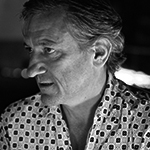
Klaus Spiess (Austria)
Klaus Spiess is an endocrinologist, psychosomaticist and medical anthropologist who now works as an associate professor in the field of art and science at the Medical University of Vienna. His performances and installations (all together with Lucie Strecker) address biopolitical issues in medicine and have been shown at numerous performance and exhibition spaces (Budascoop Kortrijk, Tanzquartier and Belvedere/21er Haus Vienna, Haus der Kulturen der Welt, Berlin, the BEALL Center for Art + Technology, Irvine, the Onassis Cultural Center Athens, the Bemis Center of Contemporary Arts Omaha and the OK Center, Linz, where he was awarded an Honorary Mention at the Prix Ars Electronica. He has published numerous articles on his transdisciplinary work (Performance Research, Kunstforum International, Springerin, The Lancet and Leonardo, among others).
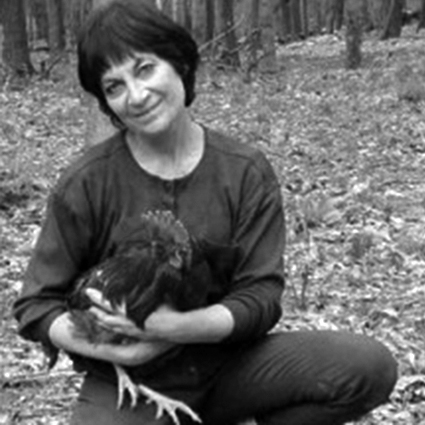
Linda Weintraub
Linda Weintraub is a curator, educator, artist, and author of several popular books about contemporary art. She has earned her reputation by making the outposts of vanguard art accessible to broad audiences. The current vanguard, she believes, is propelled by environmental consciousness that is not only the defining characteristic of contemporary manufacturing, architecture, science, ethics, politics, and philosophy, it is delineating contemporary art. “TO LIFE! Eco Art in Pursuit of a Sustainable Planet” was preceded by the series, Avant-Guardians: Textlets in Art and Ecology (2007). It includes EcoCentric Topics: Pioneering Themes for Eco-Art; Cycle-Logical Art: Recycling Matters for Eco-Art; EnvironMentalities: Twenty-two Approaches to Eco-Art. Weintraub established Artnow Publications in order to apply environmental responsibility to the books’ material production. Linda applies these environmental concerns to her personal life by managing a sustainable homestead where she practices permaculture. Weintraub is also the author of In the Making: Creative Options for Contemporary Artists and Art on the Edge and Over: Searching for Art’s Meaning in Contemporary Society. She edited ANIMAL. ANIMA. ANIMUS with Marketta Sepalla; served as the director of the Edith C. Blum Art Institute located on the Bard College campus where she originated fifty exhibitions and published over twenty catalogues; and held the position of Henry Luce Professor of Emerging Arts at Oberlin College. Dear Mother Nature at the Dorsky Museum, SUNY New Paltz is the most recent exhibition she curated. Other exhibitions include Lo and Behold: Visionary Art in the Post-Modern Era, Process and Product: The Making of Eight Contemporary Masterworks, Landmarks: New Site Proposals by Twenty Pioneers of Environmental Art, Art What Thou Eat: Images of Food in American Art, and The Maximal Implications of the Minimal Line. Weintraub received her MFA degree from Rutgers University.

Lucie Strecker (Austria)
Incoming Art|Sci artist in residence, she has been developing trans-disciplinary performances and installations that address biopolitical issues for five years. An artist and stage director, she holds a senior postdoc position at the University of Applied Arts Vienna. She has performed at Budascoop Kortrik, Tanzquartier & Belvedere/21 Haus Kortrijk, Tanzquartier and Belvedere/21er Haus, Vienna and her installations have been shown at the Haus der Kulturen der Welt in Berlin, the BEALL Center for Art + Technology in Irvine, and the OK Center in Linz, where she was awarded an Honorary Mention (2015) at the Prix Ars Electronica. She has published articles on her trans-disciplinary performances in Performance Research, Kunstforum International, Springerin, and The Lancet, among others.
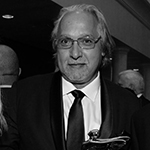
Mark Chavez
Mark Chavez is an animator, artist, educator and entrepreneur who has developed systems and techniques for animation across various media. He has worked on more than numerous award winning major feature films and innovative interactive titles to his credit at animation studios such as LaserMedia Inc. Los Angeles, Philips Interactive Media, Tokyo Broadcasting System (TBS) Japan, Acclaim Entertainment New York, Dreamworks Feature Animation Glendale and Rhythm and Hues Studios Los Angeles. Animation industry veteran and founding faculty at Nanyang Technological University’s School of Art, Design and Media’s Digital Animation area, he is currently based in Singapore and Los Angeles, founder of Giant Monster Pte Ltd. Mark holds a Master’s of Fine Art from UCLA.
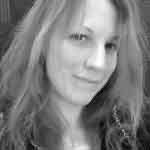
Martina Fröschl (Austria)
Editor-in-chief at CGmag. After studying at the Universities of Applied Sciences in St. Pölten and Hagenberg, Martina started working for the Industrial Motion Art visual effects and digital art studio in Linz and later Vienna. Currently, she is working on her doctoral thesis at the University of Applied Arts Vienna. Under Professor Alfred Vendl she is creating marine biology animations for the new collaboration with Victoria Vesna and the ArtSci team -- the Noise Aquarium. Visiting us from Vienna, Austria, where she is a senior researcher and doctoral student at the Science Visualization Lab Angewandte at the Department of Digital Art at the University of Applied Arts Vienna. The depiction of realities and biological phenomena has continuously driven her creations. Martina will be talking with us about her collaboration/piece at SIGGRAPH, and the role that CGI and animation have played in creating very alive and immersive works about the environment.

Miu-Ling Lam (Hong Kong)
Dr Miu Ling Lam is a media artist and researcher of robotics, interactive media and bioinformatics. Her most recent research focuses on 3D immaterial displays, visual-odometry-based robotic cinematography, and computational models for single molecule DNA profiling. Her work has been published in scientific journals and book chapters, such as Journal of The Royal Society Interface, Sensors and Actuators, IEEE Transactions on Robotics, and Journal of Laboratory Automation, as well as leading robotics and computer graphics conferences. Her earlier research includes multi-fingered robotic grasp, geometric algorithms for wireless sensor network deployment, and obstacle avoidance for redundant manipulators using neural network. In er postdoctoral fellowship she specialized in nanotechnology and art-science. She joined the School of Creative Media at Hong Kong CityU after her residency.
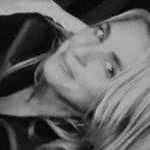
Mónica Mendes (Portugal)
is a digital media artist, designer and assistant professor coordinating the Multimedia Art degree at the University of Lisbon. She is also a researcher at M-ITI - Madeira Interactive Technologies Institute, collaborator at CIEBA – Centro de Investigação e de Estudos em Belas-Artes, and founding member of AZ Labs hackerspace altLab. Interested in designing for a more sustainable world, Mónica is exploring real-time interactive systems at the intersection of Art, Science and Technology.

Patricia Cadavid
Patricia Cadavid is an immigrant, artist, and researcher born in Colombia. Her work looks at the relationships and effects of coloniality in new media and sound from the migratory experience and decolonial & anti-colonial thinking.Student at the Interface Culture Lab (Kunstuniversität Linz), she received her BFA from the Universidad de Castilla-La Mancha and her MA from the Universitat Politècnica de València, multimedia &Visual arts program. Her work has been exhibited in different festivals such as Ars Electronica (Austria), ADAF (Greece), or the NIME and SEAMUS conferences as well as in several spaces in Chile, Mexico, Spain, Germany, and Colombia.

Patricia Olynyk
http://www.patriciaolynyk.com/
Her work examines the wars in which culture and institutional structures shape our knowledge and understanding of history, science, and the natural world. Appropriating medical imaging technologies and methods of collecting, documenting, and exhibiting scientific artifacts. Her work addresses how interpretation fluctuates between fact and speculation. Her installations, sculptures, photography and performances operate at the intersections between sensing and knowing, and order and affect. http://www.patriciaolynyk.com/

Robertina Šebjanič
Robertina Šebjanič is an internationally awarded artist, whose work revolves around the biological, chemical, political and cultural realities of aquatic environments and explores humankind’s impact on other species and on the rights of non-human entities, while calling for strategies emphatic towards other species to be adopted. In her analysis of the theoretical framework of the Anthropocene, the artist uses the term ‘aquatocene’ and ‘aquaforming’ to refer to humans’ impact on aquatic environments. Her works received awards and nominations at Prix Ars Electronica, Starts Prize, Falling Walls.
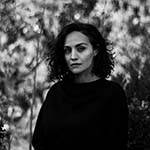
Sholeh Asgary
Sholeh Asgary is an interdisciplinary sound artist whose immersive works, performances, and audience-participatory scores implicate the viewer-participant into future mythological excavations. Her practice bridges vast stretches of time and history through the use of water, water clocks, crude oil, movement, light, imaging, voice, and sound. Asgary has exhibited and performed at institutions such as ARoS Kunstmuseum, Sotheby’s Institute of Art, Euphrat Museum, and Gray Area Foundation for the Arts. Her work has received support through numerous residencies and awards, including Mass MoCA (2021), Headlands Center for the Arts (2021), California Arts Council (2020), and the Kenneth Rainin Foundation NEW Commissioning grant through Dance Elixir (2019). She is currently a Lecturer at UC Berkeley’s Department of Art Practice and serves on the curatorial council at Southern Exposure in San Francisco, CA. Born in Tehran, Iran, she holds degrees from Mills College (MFA) and San Francisco State University (BA). About the Performance: Qanat is an interactive sound and light installation named after the ancient Iranian underground water channel system. By amplifying the resonant qualities of a traditional rug with the sound of water, a pendulum microphone above picks up rug vibrations, movement, and room tone, creating a live feedback loop. Visitors are invited to sit, lie, or stand on the rug, altering the transmission of sound throughout the gallery. The exhibition also includes embossed topographical prints created by Asgary’s breath and a video work referencing water, transmission, and incommunicability. Qanat reminds us that we are all born into the comforting darkness of sound and water. Performance and Special Event Date and Time: Friday, May 16, 2025, 4:30 PM – 6:00 PM Location: Botanical Garden Details: Live vocal rendition of Qanat 5 by Sholeh Asgary, with a potential live performance featuring Electronic_Khipu_ by Patricia Cadavid.

Vera Wittkowsky
Vera is a master student at the Interface Culture Lab, University of Art and Industrial Design Linz and doctoral candidate in philosophy at the University of Applied Arts Vienna. Her research interests are the artificial replica in the image of the human as well as the ethical and social implications of science and technological progress, utilizing a broad interdisciplinary approach. March and April 2019.
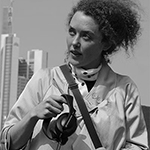
Yolande Harris
Yolande Harris is an artist and scholar engaged with sound, its image and its role in relating humans and their technologies to the environment. Her artistic research projects consider techniques of navigation, sonification of data, sound worlds outside the human hearing range, and underwater bioacoustics. They take the form of audio-visual installations and performances, instruments, walks, performative lectures and writings. She weaves together her artwork with her theories of techno-intuition and sonic consciousness, in which expanded forms of awareness emerge through technological media and critical listening techniques. Her work is presented internationally in the context of visual art exhibitions, music venues and media art festivals and conferences.

